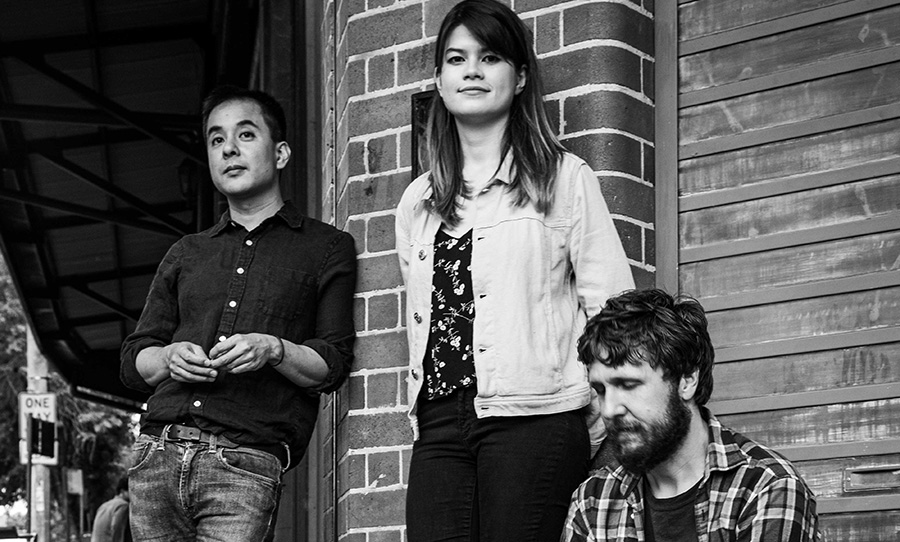Words by Carmen, guitarist in Grids & Dots.
My role in Grids & Dots switches between creating wide and lush sounds in the background and writing lead guitar and vocal melodies that comes in an out with our other guitarists fast strutting guitar sounds.
I use a Telecaster mainly since I find it provides the warmest and most stable sound, but more importantly, it’s light and doesn’t give me shoulder pains when we rehearse for a long time! My favourite guitar is my Fender Jazzmaster, the tones are punchy yet warm at the same time. I also use the whammy bar for making my guitar sing a soft and dissonant sound.
When writing the parts for each song, I always try out different effect pedals, or use different distortions to cut out high-end frequencies, so that I can create interesting sounds with my reverb-delay-reverb combinations.
If you’ve spent the past couple of weeks spellbound by Grids And Dots like we have, here’s a run-down of how they achieve their hypnotic sound.
My pedal board includes:
Mooer micro Pitch box
I use the detune effect on the Moore micro pitch box which adds notes around the current note played by 1-12 semitones. The detune option mixes a subtle pitch shift with your original guitar tone for a spacey, ambient sound that isn’t a million miles away from a chorus or tremolo, but different enough to stand out on its own. This pedal is a little tricky to use since sometimes if you add and spread too many notes, the sounds end up clashing too much with another guitar that is playing rhythm.
Digitech Polara
I use the Digitech Polara purely for the reverse reverb effect. I can create an almost cello-like sound by combining it with the Diamond Memory Lane. I then use the Afterneath reverb pedal to add sparkle and hollowness so that each note spreads like glitter in the air for about 8 seconds. The sound effect was inspired by The Cocteau Twins, and also the slow stretched out background sounds in Slowdive’s song ’Souvlaki Space Station’.

Earthquaker Devices – Afterneath
The Afterneath is used in almost all of our songs which has fast strumming. The Afterneath is the most magical (reverb) pedal I have ever come across. Even with the mix turned onto 10%, the subtle diffuse and sparkle effect still helps the guitar create a perfect depth and space to make the audience feel like they’re being transported into another planet.
Diamond Memory Lane Jr.
The Diamond Memory Lane Jr is the main delay pedal I use. It has an analogue sound and ability to add modulation to delay and in-sync sound. What’s really special about this delay is that the tap tempo can be switched with a 1/4 note, dotted 8th and 8th note triplet subdivisions a quick flick of the little toggle switch. It’s useful if I have a strumming section I the song where I want a dotted rhythm coming in.
Seymour Duncan Dark Sun Delay + Reverb pedal
The Dark Sun Delay was a game-changer for me, since all my songs I use different effects, having the ability to save a specific and differing effect into a bank of sounds allows me to change up my sound from one song to the next fairly quickly. It also gives me such exact control both reverb and delay, the depths, tracking the sensitivity in which I play (so that I can automatically dial down effect dials down when I hard) and also the order in which the reverb and delay are routed.

Mooer Green Mile
I use this to add a bit of crunch in our songs. The small footprint it has on my pedalboard also allows me to use it as a volume control as well sometimes when I need to dial sound down whilst adding a bit of overdrive. This was the first pedal I ever bought – and as silly as it sounds I bought it because it’s a pastel baby turquoise colour (my favourite colour), so it holds a special place in my heart.
Earthquaker Devices – Westwood
Finding a good overdrive pedal has taken me a long time, over the past 7 years I have used a different overdrive each year, only to finally settle on this as my favourite overdrive where I feel like I have total control over the sound. In the past, It always seems like the threshold between “sound on” and “NOOO THIS IS TOO MUCH” was only a 3 degrees turn away in the knob. It felt like the range with most distortions was this: 1.0-25% – no distortion at all, 25%-27% good amount of distortion, 28%-100% jarring ear-bleeding distortion that makes me wanna cry. So finding that tiny 2% was always fiddly nightmare. Thanks Westwood, you’re really the perfect balance of an easily controllable range of warm crunchy overdrive.
The ability to control the bass and treble also means that I can turn either the highs and lows down in a particular song to cut my volume and open up space for the rest of the band.
Thanks so much for reading my gear guide! Come check us out at the Chippo Hotel on the 16th of Jan for our single launch.
Never Change is available now. Listen here.



